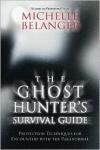
Reviewed by Tom Ruffles
There is more than one way to conduct a paranormal investigation and, while it will not necessarily be to the taste of those who take enough surveillance gear on vigils to equip MI5, there is much of interest in Michelle Belanger’s book. In particular, it will be of use to those who feel that they are experiencing entities in their homes, and do not know where to turn for advice.
There is much talk of ‘energy’, but Belanger is careful to note that she is using the term as an approximation for what, as she sees it, provides the common ground for both us and ghosts; she refers to energy “as a kind of linguistic placeholder.” This is not a type of energy amenable to instrumentation, relying rather for detection on human psychic abilities, which she insists we all have to a greater or lesser degree (and which can be developed). She admits that it will be dismissed as imaginary by many if an alleged spirit does not deflect the needle on a whatsitometer, but argues that the human being is more sensitive – and much less understood – than our technology, capable of detecting phenomena to a greater degree than an electronic device.
The heart of the book is a series of techniques focusing on developing the ability to interact with this energy in order to deal with spirits, and Belanger provides a step by step guide, in clear language, to the basic principles. Chapters deal with establishing personal boundaries, cleansing a house, understanding the motivations, or lack of them, of spirits, and evicting those that are definitely a nuisance. She also discusses the use of symbols, which she considers useful tools, but contends that what they are is less important than their underlying meanings and the intent with which they are used.
As a device upon which to hang her explanations, Belanger uses a case study format. This shows how an ordinary chap, ‘Irving’, pestered by an infestation of spirits in his house, is transformed with help from Belanger and a colleague from a victim scared of his own shadow, not to mention those in the wardrobe, into someone with the self-assurance to take charge of his situation. The core of the book is about psychic self-defence, a determination not to be intimidated by things that go bump in the night, but rather to understand them, accommodate them where possible, and deal with them firmly when necessary. The stress is on empowerment rather than helplessness.
Ghost hunting groups have proliferated hugely in recent years, often on a commercial basis, but there is no reliable method of assessing their effectiveness. It takes a great deal of faith to trust yourself to strangers solely on their word, particularly when you are in a stressful situation, and although Belanger has designed this book primarily for group use, it will also be of value to individuals with little prior knowledge of the subject who believe that they are experiencing a paranormal situation. Whatever one thinks of the theoretical basis of her approach, Belanger has supplied tools that will give them the confidence to tackle it themselves, and confidence is largely what it is all about.
Where Belanger scores over many of the more nuts and bolts guidebooks is that she takes what is effectively a client-centred approach – and in a sense that includes the ghosts. For her, the person faced with the situation is more than simply part of the investigation, as is so often the case with groups, who can be insensitive to the needs of those that they are ostensibly trying to help. This puts control back into the hands of the victim, and the techniques can be used by those who have varying religious beliefs and who prefer to trust a ‘higher power’, or who have none at all.
The book is free from dogma, and Belanger stresses that there are many variations on the principles she describes. The important thing, as she says, is that whatever is happening stops, and how it happens is of secondary importance. She has wise words for paranormal groups who may seek to impose a particular interpretation on a situation. Given how little we still know about the subject, it is arrogant to assume that a particular view is the only one, and she urges ghost hunters to resist portraying themselves as bearers of THE truth, and to acknowledge that any explanation that they may offer has limitations.
Those spontaneous case researchers who prefer to stick with their instrumentation might still profit from a consideration of the techniques discussed, even if they only consider them to be psychological props. Groups often use mediums whose role is as much social worker as conveyor of information; they provide a narrative that the householders can accept, the unknown becomes known (at least to the clients’ satisfaction), and tension is removed from the situation. Belanger does not talk about the use of mediums because she feels that we all have that ability within ourselves (and she certainly does not agree with the concept of moving spirits ‘into the light’, considering it presumptuous to assume we are the best judges of the spirits’ needs) but the techniques she describes fulfil much the same role of taking the heat out of the situation and giving back a sense of control. And if the researcher gains information in the process, everyone wins.

